- Task execution log
- IDs application
- Import objects from file
- Recycle bin
- System settings
- Number settings
- Licence settings
- Language packs
- IDs
- ID groups
- ID types
- Print templates
- Segments
- Locations
- Number generators
- Note types
- Tasks
- Task types
- Update packages
- VAT rates
- Search for information by ID
- Screen form print formats
- Supplied system tasks
© Tillypad, 2008-2015
Table of Contents
- Task execution log
- IDs application
- Import objects from file
- Recycle bin
- System settings
- Number settings
- Licence settings
- Language packs
- IDs
- ID groups
- ID types
- Print templates
- Segments
- Locations
- Number generators
- Note types
- Tasks
- Task types
- Update packages
- VAT rates
- Search for information by ID
- Screen form print formats
- Supplied system tasks
The section incorporates the service directories and lists that are required for the operation of Tillypad XL.
Functions:
managing IDs of employees and regular customers as well as all ID types used in the system;
ensuring the connection between Tillypad XL Manager and the segment database;
configuring user licences in Tillypad XL;
storing and editing information saved when installing the system;
managing automatic numbering of objects created in Tillypad XL;
managing subscriptions for data replication;
managing automated tasks;
configuring settings for multilingual interfaces of programs and print layouts;
creating and editing additional attributes of objects to adapt them to your needs;
importing objects from external files;
restoring deleted directory items.
The section can be accessed via the section in the main menu.
The section contains operational reports, operations , settings directories, and directories.
Import from external files operation,
You can open these reports, as well as this list and operation from the submenu in the main menu.

The list contains information that has been deleted from directories. If necessary, this information can be restored from the Recycle bin to its original directories.
The section includes the following settings directories:
You can find the settings directories under in the menu.

The directory contains the global default settings used in Tillypad XL: currency formats, stock item properties formats, etc. VAT rates are added to the system settings from the directory.
The directory contains a list of number generators that correspond to different object types.
The directory contains information about licences in use.
The section incorporates the following directories
You can find the directories under in the menu.

The
directory contains language packs with the languages that employees, clients, devices and others use when working with the system.
IDs assigned to individuals (employees, regular customers, representatives of partners) are stored in the directory. ID types used for individuals, stock items, or menu items are stored in the directory.
IDs can be grouped according to any criteria, e.g. IDs for employees, IDs for clients. ID groups can be managed in both the
and
directories.
The directory contains general settings relating to the operation of system segments and the Tillypad XL context help guide. Here you can configure the replication subscription settings for objects of the system.
The directory is used to specify physical locations of divisions, stores and devices.
The directory contains formats for automatically generated document numbers.
The directory contains a list of note types that are used to add new attributes to different elements of the system. Note types can be created by the user to add extra parameters to directory items. Additional panels with notes will appear in these window items. User-created parameter values can be entered in the notes panels.
The list contains tasks that can be launched manually or scheduled to start automatically. The directory contains the attributes of standard tasks used in the program.
The directory is used to store object packages (items and groups from different directories) to be exported to an external file or to be imported from the file. Using packages, you can easily update objects without having to upgrade the database.
The directory includes the value added tax rates used in Tillypad XL Manager.
The directory contains print layouts that can be used by print layouts of other objects in the system: reports, software module print formats, etc.
